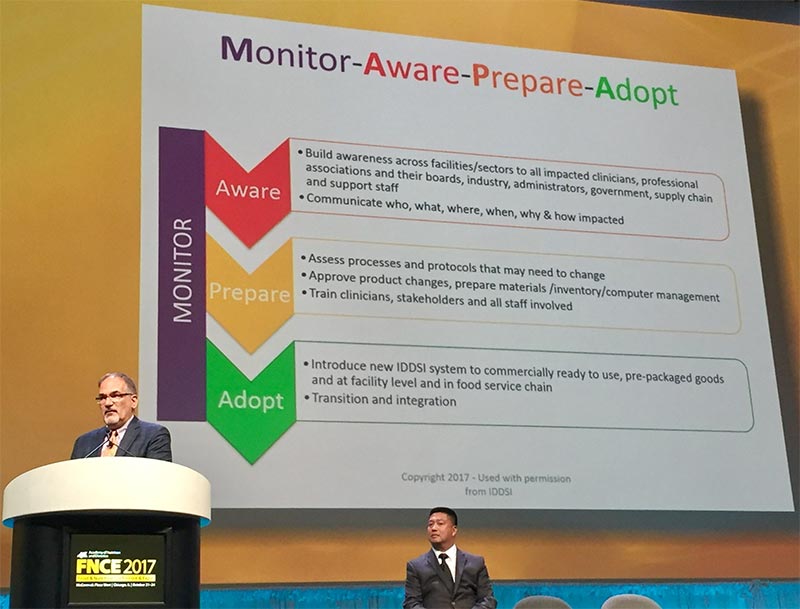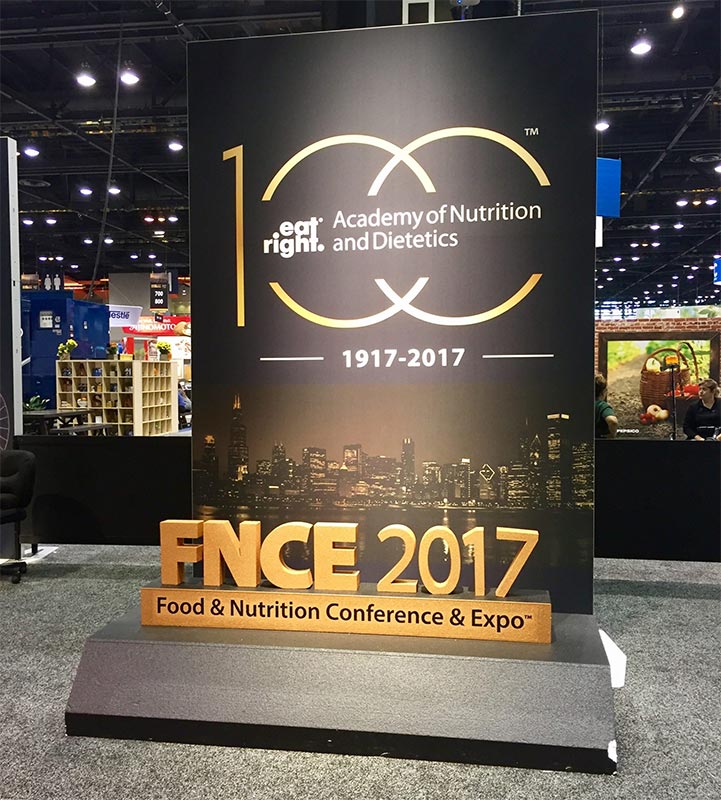ASHA + AND = Better Together: SLP & RD Collaboration in Dysphagia
by Karen Sheffler, MS, CCC-SLP, BCS-S of SwallowStudy.com
“Are you going to /fɛnsi/?” (Yes, that was the international phonetic alphabet (IPA) to show SLPs how to pronounce FNCE. I am a Speech-Language Pathologist (SLP) who has specialized in swallowing and swallowing disorders (dysphagia) since 1995. I have collaborated with numerous dieticians across the continuum of care, and I did not know what “FNCE” was.
What is FNCE?
The acronym FNCE is the Food & Nutrition Conference & Expo of the Academy of Nutrition & Dietetics (AND). This is the big annual convention for Registered Dietitians (RDs). FNCE has been happening annually since 1917, which is longer than the ASHA convention for SLPs. Happy 100 year anniversary to the AND! The AND can really celebrate with an attendance of almost 14,000 people! Included in that attendance were only a handful of Speech-Language Pathologists, like myself. I liked to joke that we were infiltrating this conference; however, it was strategic. The American Speech-Language-Hearing Association (ASHA) has a strategic objective on Inter-professional Education and Practice to encourage and support ASHA members to receive interdisciplinary education and to collaborate in practice. SLP and RD collaboration in dysphagia evaluations and management is especially important. ASHA had a booth for the first time in the FNCE expo hall. I believe this is highlighting that the future is brighter with ASHA and AND together.
I was inspired by a quote at FNCE from Susan Finn, PhD, RDN, FAND. Her words spoke to this SLP and RD collaboration and show the similarities in our missions:
“Where will we be in the next 10 years? I can sum it up in three words:
higher, deeper, and broader.
We must elevate our professional profile,
increase our depth of knowledge in all aspects of food and nutrition science, and
seek opportunities to extend our influence by partnering with like-minded organizations.
This is our path to recognition as leaders in global health and trailblazers in solving nutrition challenges worldwide.”
This statement really rings true for our field of medical speech pathology and swallowing as well (just replace “nutrition” with swallowing and swallowing disorders). I will related how these three concepts are also important to SLPs:
- Regarding elevating our professional profile, many SLPs who specialize in dysphagia have also been working to raise awareness of the importance of early identification swallowing impairments (e.g., swallow screening immediately after stroke, followed by comprehensive evaluations by an SLP when needed). At FNCE, I talked with many registered dieticians (RDs) about our common ground. For example, we see doctors focused intently on curative efforts across all the other systems of the person’s body, while sometimes glancing over nutrition and swallowing. We remind the team: “If he/she is not obtaining adequate nutrition and hydration safely, all this aggressive effort may be futile.”
- Regarding digging deeper to increase our knowledge-base as a field, there are many SLP researchers and clinicians who advocate for increased critical thinking when it comes to dysphagia evaluation and management. (Check out ASHA’s resource here: ASHA Practice Portals). There are many myths out their regarding this complex field of dysphagia, as well as in the nutrition world. Think of all the miss information that the public can find on the internet about fad diets. That must be like fingernails on a chalkboard to a registered dietitian, who keeps up-to-date on the latest scientific evidence. SLPs hear you! SLPs also lament about the shear quantity of myths in dysphagia, such as: “Just tuck your chin, it will always prevent aspiration,” and “The thicker the liquid, the better.”
- Most inspiring, regarding our opportunities to collaborate, ASHA and the AND are perfectly poised to partner in this 2nd century. ASHA’s history dates back to 1925, so ASHA will be looking to their 2nd century soon! Gennith Johnson, M.C.D., CCC-SLP, Associate Director of Health Care Services in Speech-Language Pathology, was at the ASHA booth promoting this AND and ASHA collaboration. She also shared with RDs what the SLP scope of practice is regarding feeding, swallowing and feeding/swallowing disorders. She helped educate on the International Dysphagia Diet Standardisation Initiative (www.IDDSI.org). She commented:
“ASHA’s participation (in FNCE) was made possible as part of ASHA’s Strategic Pathway Objective to support Interprofessional Education/Interprofessional Practice. Funds were approved to allow ASHA to exhibit at the professional meetings of several other organizations in 2017. ASHA was pleased to be present at FNCE 2017 to encourage and support speech-language pathologists and dietitians to work collaboratively to improve the lives of the individuals they serve.”
IDDSI: Perfect Example of SLP & RD Collaboration in Dysphagia
In fact, IDDSI (pronounced /ɪdsi/) is the best example of the need, especially now, for focused interdisciplinary education and collaboration to ensure the health, safety and nutrition/hydration for our patients. This is a global diet standardization movement that will allow all stakeholders to speak a common language, across the lifespan, and across care centers for the safety of our patients with swallowing disorders.

Go to www.IDDSI.org for framework, descriptors and testing methods.
A joint press release from January 31, 2017 highlighted how patient safety is a joint focus for SLPs and RDs:
“The Academy of Nutrition and Dietetics (AND) and the American Speech-Language-Hearing Association (ASHA) together announce their support of a new global initiative (IDDSI) to standardize diets for the treatment of people who suffer from swallowing disorders.”
IDDSI had a great presence at FNCE this year with dieticians and speech-language pathologists presenting together in an educational session and in the expo hall. Many industry partners were also helping to promote and educate about the new IDDSI framework. Some dieticians questioned if they could expect the support of their fellow SLPs, and IDDSI assured them that this initiative has the full support of both of our organizations. Implementation will take time, though. Start now with raising awareness. (Read more on why we need to standardize: My first blog called: “Diet Safety: Terminology & Definitions Matter,” and my second blog: “No Dysphagia Diet Modification Without Standardization.”) The next steps will be to prepare our facilities and start the adoption process to the IDDSI framework by May 1, 2019. (Read more about early adopters of the IDDSI framework: See IDDSI publication on the Kempen Pilot – about a hospital in Germany. See also My Interview with another Early Adopter). IDDSI encourages frequent monitoring throughout this process of change. See this “MAPA” process in the picture below. MAPA will guide the transition to IDDSI, and the word just happens to spell “map” in Spanish, as noted by Luis F. Riquelme, PhD, CCC-SLP, BCS-S.
Riquelme and Peter Lam, RD, CFE are seen here presenting at FNCE. They are both members of the IDDSI Board of Directors (with Lam as a Co-chair along with Julie Cichero, an SLP from Australia).
Start your increased collaboration in dysphagia now. Have you called your RD today?
If you are an RD, have you talked with your SLP today?
Quick Calls to Action for Everyone on IDDSI:
In addition to the embedded links for more information above, take at least these three first steps to be informed about IDDSI. If you do go to #ASHA17 or any future meetings, please share your #IDDSI news on social media to continue to #RaiseAwareness. Thank you!
- Check out the IDDSI website: www.IDDSI.org. The resource page has open access pdfs of all the IDDSI research. Use the Sign Up For News tab to receive the latest news.
- Download the free IDDSI app from your App Store by searching: “IDDSI.” This app can be used at work when communicating with your fellow staff, as it does not need wifi or data to run. You can find all the diet labels and descriptors of levels 0-7. You can watch all the videos to help understand the testing methods for foods and liquids (e.g., the Flow Test to make sure your thickened liquids and supplements are the appropriate viscosity).
- Go to the IDDSI YouTube Channel! Watch the many training videos.
- Look for opportunities to learn more about IDDSI at ASHA Conventions, state meetings and the Dysphagia Research Society meetings, as well as on social media!
2019 IDDSI Updates:
- Please keep sharing your #IDDSI stories & connect with @IDDSI_org on Twitter.
- Check out: Hormel Health Labs Free IDDSI Webinars on BeckyDorner.com: https://www.beckydorner.com/
hormelhealthlabs/
So Many 2021 Updates:
- Check out IDDSI on Instagram!
- Stay tuned for updates and implementation assistance from the newly formed United States & Territories IDDSI Reference Group (USTIRG).



I have read your post it’s very informative and helpful too for readers .Thanks for sharing your knowledgeable content with us and keep updating us with such great informative post.Keep writing.